the place where Paleontology and Paleoanthropology meets Philately
Grenada (Grenadines, Carriacou, Petite Martinique)
Dinosaurs and other prehistoric animals, fossils, Charles Darwin on stamps of Grenada
| << previous country | back to index | next country >> |
Contents:
- Country overview
- Philately of Grenada
- Official stamps of Grenada related to Paleontology
- Other stamps of Grenada to consider
- Official stamps of Grenada - Grenadines
- Official stamps of Grenada - Carriacou and Petite Martinique
- References
- Acknowledgement
Grenada is an island country in the British Commonwealth consisting of the island of Grenada and six smaller islands at the southern end of the Grenadines in the southeastern Caribbean Sea. Grenada is located northwest of Trinidad and Tobago, northeast of Venezuela, and southwest of Saint Vincent and the Grenadines.
Most of the population lives on Grenada, and major towns there include the capital, St. George's, Grenville and Gouyave.
The country size is 344 square kilometres, with an estimated population of 110,000.
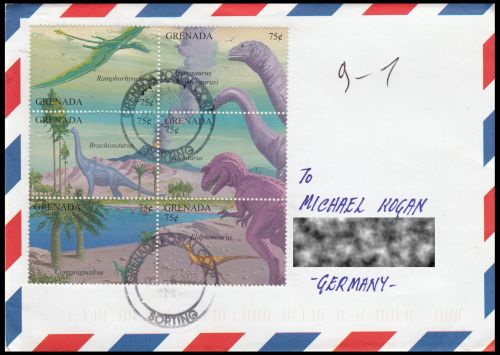 |
| Regular letter from Grenada, with stamps of prehistoric animals from 1994, sent to Germany. |
The French settled Grenada in the 17th century, established sugar estates, and imported large numbers of African slaves. Britain took the island in 1762 and vigorously expanded sugar production. In the 19th century, cacao eventually surpassed sugar as the main export crop; in the 20th century, nutmeg became the leading export. In 1967, Britain gave Grenada autonomy over its internal affairs. Full independence was attained in 1974 making Grenada one of the smallest independent countries in the Western Hemisphere. [R1]
The first stamps of Grenada were issued right after it gained independence from Great Britain on 7
Stamps inscribed "Grenada Grenadines" were issued from 1973 to 1999 for the islands of the Grenadines located to the north of Grenada.
Since 1999, stamps for the Grenadines are marked "Grenada Carriacou & Petite Martinique". [R2]
Since the 1980s, this country has issued many stamps per year and ranks as one of the countries that has issued the most stamps per year. Therefore, all stamps of Grenada are labeled as Undesired.
Official stamps of Grenada related to Paleontology: dinosaurs and other prehistoric animals, Charles Darwin
| 13.04.1994 "Prehistoric Animals" | 15.04.1997 "Dinosaurs" | 01.09.1999 "Dinosaurs" |
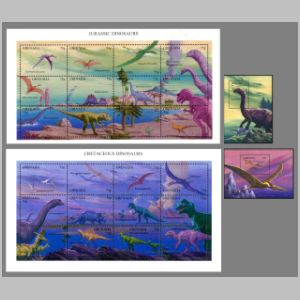 |
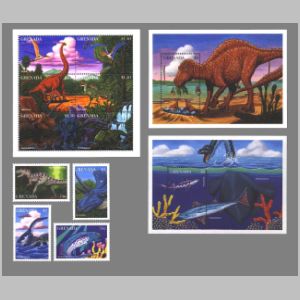 |
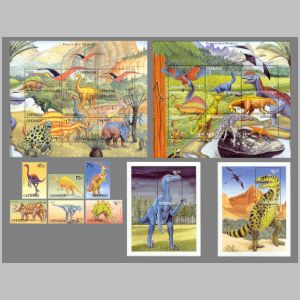 |
| 23.10.2003"Prehistoric Animals" | 10.02.2005"Prehistoric Animals" | 21.08.2009"Charles Darwin" |
 |
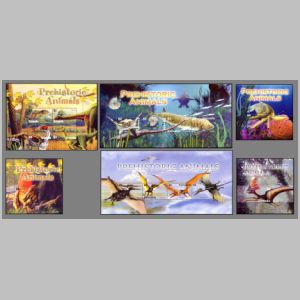 |
 |
Other stamps of Grenada: contributors to Paleontology science
| 29.04.1991 "Voyages of Discovery" [1] | 16.07.2007 "American Presidents" [2] | |
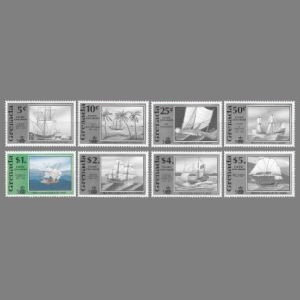 |
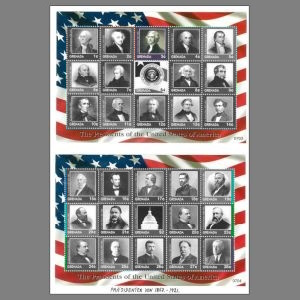 |
|
Notes:
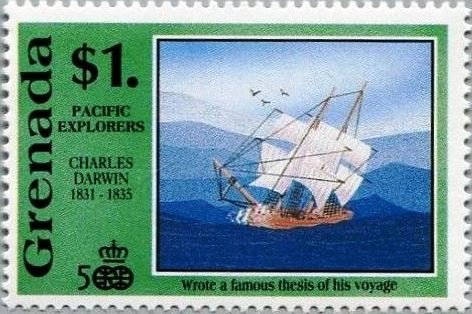
|
| HMS Beagle on stamp from the set "Voyages of Discovery" of Grenada 1991 MiNr.: 2239, Scott: 1955 |
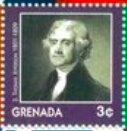
|
| Thomas Jefferson among other American Presidents on stamps of Grenada 2007 MiNr.: 5882, Scott: 3651c |
HMS Beagle was a Cherokee-class 10-gun brig-sloop of the Royal Navy, one of more than 100 ships of this class.
On the second voyage a young naturalist named Charles Darwin was on board; the pivotal role this round the world voyage played in forming his scientific theories made the Beagle one of the most famous ships in history.
Darwin kept a diary of his experiences, and rewrote this as the book titled Journal and Remarks, published in 1839 as the third volume of the official account of the expedition.
This travelogue and scientific journal was widely popular, and was reprinted many times with various titles, becoming known as The Voyage of the Beagle.
This diary is where Darwin drew most of the ideas for his publications. Darwin attributes his first real training in natural history to his voyage on the Beagle.
[2] Thomas Jefferson "Farther of American Paleontology" depicted on stamp with face value of 3c
Thomas Jefferson is rightfully renowned as the principal author of the Declaration of Independence, the Third President of the United States, and a champion of Liberty.
But he was also a central player in the beginnings of American paleontology.
More information about Thomas Jefferson and his role in establishment of American Paleontology can be read on "Contributors to Paleontology science" or USA catalog pages.
Other Islands of Grenada who produced some Paleontology related stamps
Grenada - Grenadines
The Grenadines
is an island chain that is part of St.Vincent and Grenada. There are 32
islands and cays that make up St. Vincent and the Grenadines
(SVG). They are divided between the island nations of Saint
Vincent and the Grenadines and Grenada. The islands north of
the Martinique Channel belong to Saint Vincent and the Grenadines and
the islands south of the channel belong to Grenada.
[R1]
| 14.04.1994 "Prehistoric Animals" | 15.04.1997 "Prehistoric Animals" | 01.03.1999 "Dinosaurs" |
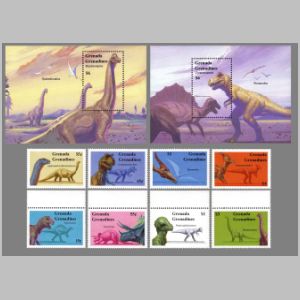 |
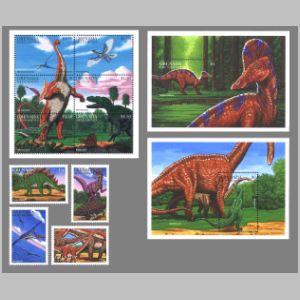 |
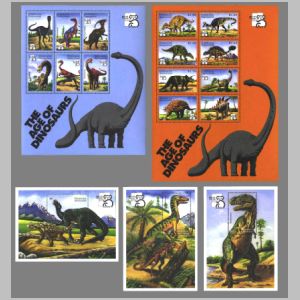 |
Grenada - Carriacou snd Petite Martinique
Carriacou Island is the largest island of the
Grenadines, an archipelago in the Windward Islands chain.
The island is 34 km2 with a population of about 5,000 persons.
The neighbouring island of Petite Martinique with its 2.37 km2 and population of 900, is smaller than Carriacou. The residents of this island live by boat-building, fishing and seafaring.
Carriacou and Petite Martinique is known for its Regatta and Village Maroon. [R1]
The neighbouring island of Petite Martinique with its 2.37 km2 and population of 900, is smaller than Carriacou. The residents of this island live by boat-building, fishing and seafaring.
Carriacou and Petite Martinique is known for its Regatta and Village Maroon. [R1]
| 10.02.2005 "Prehistoric Animals" | 15.04.2005 "Prehistoric Animals" | 07.04.2014 "Rocks and Minerals" [OI1] |
 |
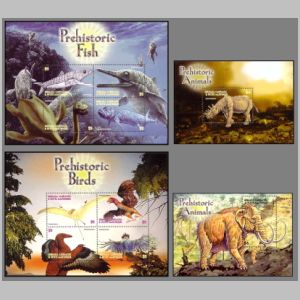 |
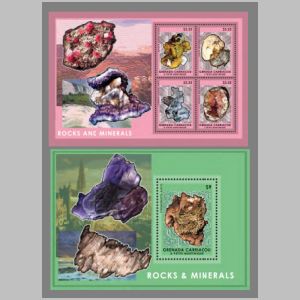 |
Notes:
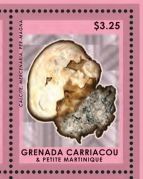
|
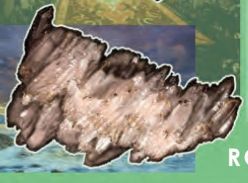
|
| Mercenaria permagna shell on stamp of Grenada - Carriacou and Petite Martinique 2014. | Petrified wood on stamp of Grenada - Carriacou and Petite Martinique 2014. |
Mercenaria is a genus of edible saltwater clam found in modern oceans and is a type of bivalved mollusc in the family Veneridae (Venus clams). The species Mercenaria permagna is only known from fossils. [R3]
Fossil shells have been found in the sediments of Russia, Japan, Indonesia, United States and Brazil.
Petrified wood shown on bottom-left corner of the second (green) Mini-Sheet.
References:
- [R1] Grenada:
Wikipedia
WikiTravel
FlagCounter
-
[R2] Postal History and Philately of Grenada:
Wikipedia
Links to official website of the Post Authority, stamp catalog and a list of new stamps of Grenada are here - [R3] Mercenaria: Wikipedia
Acknowledgement:
Dr. Peter Voice from Department of Geological and Environmental Sciences, Western Michigan University, for the draft page review and his valuable comments.
| << previous country | back to index | next country >> |